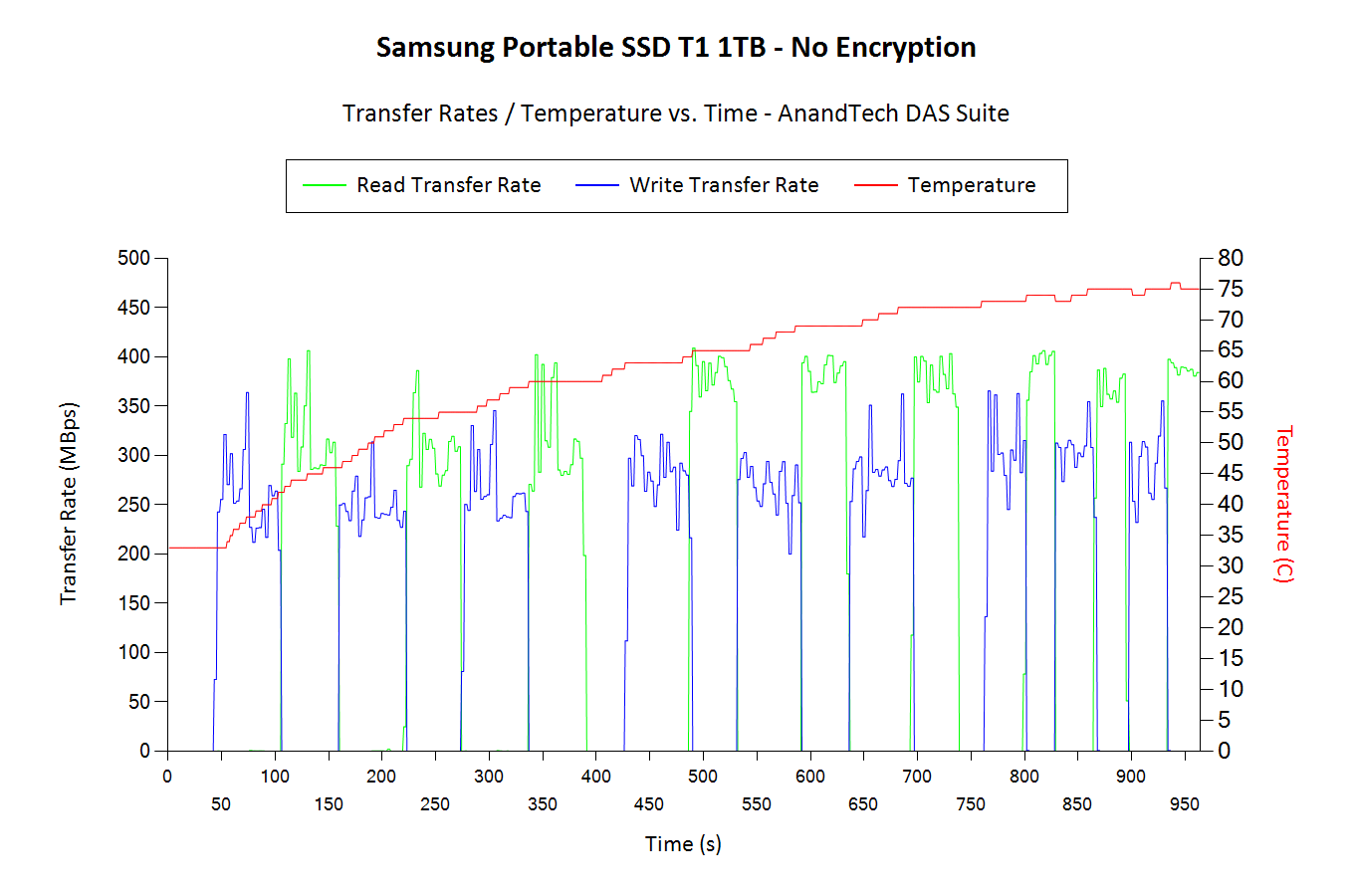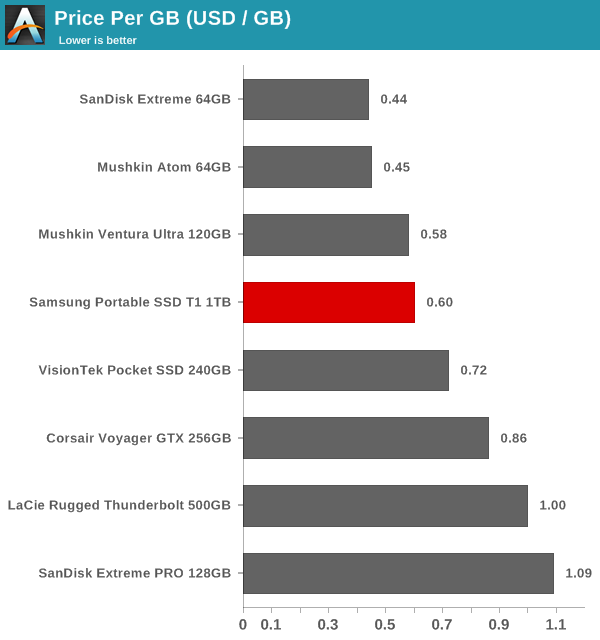Samsung Portable SSD T1 Review
by Ganesh T S on January 20, 2015 10:00 AM ESTPerformance Consistency and Concluding Remarks
Yet another interesting aspect of these types of units is performance consistency. Aspects that may influence this include thermal throttling and firmware caps on access rates to avoid overheating or other similar scenarios. This aspect is an important one, as the last thing that users want to see when copying over, say, 100 GB of data to the external portable SSD, is the transfer rate going to USB 2.0 speeds. In order to identify whether the drive under test suffers from this problem, we instrumented our robocopy DAS benchmark suite to record the flash drive's read and write transfer rates while the robocopy process took place in the background. For supported drives, we also recorded the internal temperature of the drive during the process. The graphs below show the speeds observed during our real-world DAS suite processing. The first three sets of writes and reads correspond to the photos suite. A small gap (for the transfer of the videos suite from the primary drive to the RAM drive) is followed by three sets for the next data set. Another small RAM-drive transfer gap is followed by three sets for the Blu-ray folder.
An important point to note here is that each of the first three blue and green areas correspond to 15.6 GB of writes and reads respectively. For the Samsung Portable SSD T1, we see throttling kick in only after more than 200 GB of data has been transferred continuously (the last two sets of reads in the graph below). The throttling seems to kick in after the drive temperature reaches 75 C. Another interesting aspect is the fact that the temperature rises a bit faster in the case where encryption is enabled.

A Note on TRIM
TRIM support would be really handy for a portable SSD. Usually, we don't see TRIM working over USB. However, the Corsair Voyager GTX with the Phison controller does support TRIM over the USB 3.0 interface. In addition, that drive also supports manual overprovisioning. The T1 has in-built overprovisioning, but manual control over it using the Samsung Magician software would also be nice. Of course, it is also arguable that TRIM and overprovisioning are not really needed for the T1's target market. However, for cases where the T1 is used as a portable OS drive (Windows-To-Go or some sort of portable Linux install), those features could improve user experience.
The internal platform of the T1 (the 850 EVO) does support TRIM. However, Samsung indicated that neither Microsoft nor Apple currently support issuing TRIM commands through the USB interface on their current OS. That said, they are exploring additional methods of forcing TRIM - including manually through the Samsung SSD Magician software. That feature will not be available in time for the launch, though.
Concluding Remarks
Coming to the business end of the review, the Portable SSD T1 brings Samsung to the forefront of external flash drive solution vendors. Keeping the flash fabrication, controller design and fabrication as well as the solution design in-house has enabled it to put out the most reasonably priced (if not, the only) 1TB external flash drive product in the market. The size and weight of the unit are both small enough to actually let the drive hang off the USB 3.0 port as a flash drive. That said, Samsung supplies a very short USB 3.0 cable - it is perfect for notebooks, but not so in the case of desktops with USB ports in the front or rear panels.
The performance of the drive leaves us with no doubt that it would be a great portable OS drive / Windows-to-Go solution, even though Samsung doesn't advertise it for that purpose. Unfortunately, Samsung has not decided to pursue the certification process. As far as non-enterprise consumers go, this is perfectly acceptable - the performance for Windows-to-Go is there without the extra cost associated with obtaining the certification that eventually gets passed on to them.
The only minor points of concern is the inability to recognize and take actions on the drive based on S.M.A.R.T features such as TRIM.

The 1TB 840 EVO mSATA SSD has been in the market for quite some time now. Hence, the size of the Portable SSD T1 didn't come as much of a surprise. From an end-user perspective, the size / capacity of the drive and the price point ($0.60/GB) are very attractive. The Portable SSD T1 makes for a compelling solution where fast transfers of large amounts of data is needed in a secure environment.










68 Comments
View All Comments
galfert - Tuesday, January 20, 2015 - link
No TRIM....then no thanks. I'll keep my Corsair Voyager GTX for now.tipoo - Tuesday, January 20, 2015 - link
Do any drives do TRIM over USB 3?tipoo - Tuesday, January 20, 2015 - link
Ah, there it is, there's at least one device that does but most don't.Wwhat - Sunday, February 8, 2015 - link
Since internally it's just a slotted SSD module you could theoretically open the case, unplug it and stick it in your computer and trim it then.Samus - Tuesday, January 20, 2015 - link
The thing is...the write performance of the Voyager GTX is so poor in comparison to the Samsung T1, that even with TRIM support, it's slower at peak (after TRIM) than the Samsung is at its lowest point of consistency. Factor in the Voyager doesn't come in 1TB configuration and costs more per GB, you'd be crazy to buy the Voyager GTX over this.akdj - Tuesday, January 20, 2015 - link
I'm with ya Samus. Samsung is 'well' into it's design and reliability when it comes to flash, NAND, PCIe and SSD storage solutions. You'll be looking at a dime a GB by the time your T1 begins to bum out (due to lack of TRIM/S.M.A.R.T support over USB). Unless you're 'truly' using After Effects or manipulating massive RAW PS files and layers all day, every day I'm not sure it's even a concern anymore. Especially in the consumer segment.Servers and enterprise with massive user volume this may not be the perfect choice. For most, wow. A TB with these speeds and performance/heat & (lack of) throttling IMHO is a Home Run!
I've been using a 2012 15" rMBP daily, since launch with a 768GB, pre PCIe SSD. It's (still) mind numbingly quick using it's internal and external Lacie TBolt SSD. Not a single issue with the laptop or external 500GB SSD after 30 months and ten, respectively. Never a glitch
I'm sold. Will Thunderbolt allow for TRIM support?
Has Samsung built anything with Thunderbolt connectivity yet?
Thanks for the review.
J
Kutark - Tuesday, January 20, 2015 - link
In my limited knowledge, who would really need that type of speed/storage? I'm guessing for most people, even in the IT field, a 64gb or 128gb high speed USB drive is going to be more than fast enough / sufficient space. The only place i could see this being of high need would be professional photographers? I'm sure there's probably some situations out there i'm not aware of, so please correct me if i'm wrong.Basically what i'm saying is for a person who has capacity needs, a regular portable is going to be massively cheaper. For a person who has speed needs, most of the high speed USB drives are very cost effective and have good speeds vs cost. So, i'm wondering how big of a subset of people need both a lot of capacity AND a lot of speed that can justify the cost of this beast.
Laststop311 - Wednesday, January 21, 2015 - link
Not just photographers. If you are a video editor and want to have portability of your raw files on a drive 1TB should be enough space for a fairly long video and if they edit insane amounts of video they can easily buy more of them. This read transfer speed is super important for a video editor to save a ton of time transferring huge 500GB files. Also there really isn't much other choice for 1TB of space and raw uncompressed HD video needs a huge amount of space and because it's so large every drop of speed they can get the need.tipoo - Friday, January 30, 2015 - link
I sometimes have to use multiple VMs off a single external drive, SSD speeds (even across USB 3) would be a godsend for that.designerfx - Tuesday, January 20, 2015 - link
Not just that, but guaranteed heatdeath with time. Most consumer electronics aside from obvious exceptions are not built for operations at 75c, and their throttling simply confirms it. Adding vents to the "portable ssd" won't fix the fact that it's being put in an enclosure.